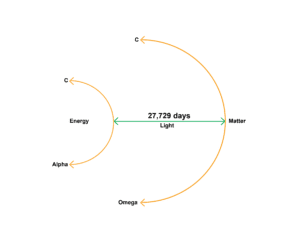We are used to thinking of what we perceive as physical objects. I am interested in the idea that our brains are expressing perceptual limits. The ocean does not end at the horizon. The horizon is just the edge of our sight.
Picture time as a cone, with a pit and a mouth. In these models, the pit is matter and the mouth is energy. We want to be in the middle—at the disc that sits between the two. We want to have the right density.
In other words, our vision may be circumscribed. At one end of time, we see light that is as dense as it can be, before becoming something else. At the other end of time, we see light that is as diffuse as it can be, before becoming something else.
In between them is the present, an “envelope” of time that stretches 27,729 days.

I was talking with my friend, Martha Carlin, whose husband, John, had Parkinson’s, about my suspicion that John’s brain was misunderstanding the density of light. I believe he was using the moon value in place of the earth value. For Martha and me, the spectrum of time stretches from dense light, to light, to diffuse light. But for John, it may span double-dense light, dense light, and light. His perception may be Alpha-shifted.
In these models, Earth is the optimum density of light; “moon” is too dense. It needs to expand, but it can’t; “sun” is holding it in place. “Sun” and “moon,” here, are twin poles of the same light. If we were to squeeze the earth to the density of moon, on the other side of time, it would expand to be as diffuse as sun. The sun, in these models, is like the moon’s halo.
It is as if we are seeing the fourth state of matter experiment writ large.
What if, in ALS (Lou Gehrig’s disease), my understanding of light is Omega-shifted. I am not viewing light—the speeding train—as itself. I am viewing light from the perspective of its track (sun). If my pineal gland is seeing from the sun’s perspective, time will look too contracted. I will see too much electromagnetism inside the cell—so I will push too much electromagnetism outside the cell.
What if, in Parkinson’s, my understanding of light is Alpha-shifted. I am not viewing light—the speeding train—as itself. I am viewing light from the perspective of its passenger (moon). If my pineal gland is seeing from the moon’s perspective, time will look too expanded. I will see too much electromagnetism outside the cell—so I will pull too much electromagnetism inside the cell.
When I pull electromagnetism inside the cell, I move forward in time. But if I move too far forward, I will begin to fill with dark matter (intracellular sodium).
When I push electromagnetism outside the cell, I move backward in time. But if I move too far backward, I will begin to be surrounded by dark energy (extracellular potassium).
The earth is the neutral baseline. In moon, light is being maximally squeezed—until it is so dense that it is surrounded by dark energy. In sun, light is being maximally stretched—until it is so diffuse that it is filled with dark matter.
In other words, in keeping with the idea that this may be a holographic universe, I am treating light as the baseline.